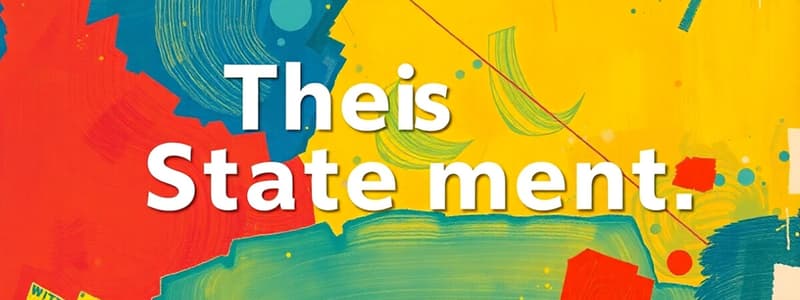Podcast
Questions and Answers
What is a first draft?
What is a first draft?
A rough stage where you get your ideas into sentences and paragraphs.
Which of the following steps is NOT part of writing the first draft?
Which of the following steps is NOT part of writing the first draft?
- Formulate a thesis statement
- Organize and develop ideas
- Edit and finalize the essay (correct)
- Choose the topic
What should be the first thing to do when writing a first draft?
What should be the first thing to do when writing a first draft?
Choose the topic.
A thesis statement conveys the central idea of a __________.
A thesis statement conveys the central idea of a __________.
What is a characteristic of an effective thesis statement?
What is a characteristic of an effective thesis statement?
What is one method to organize supporting information in a paragraph?
What is one method to organize supporting information in a paragraph?
Which organization method arranges information in time sequence?
Which organization method arranges information in time sequence?
In a chronological organization, you tell what happened ________, ________, and ________.
In a chronological organization, you tell what happened ________, ________, and ________.
What type of information arrangement ranks details from least important to most important?
What type of information arrangement ranks details from least important to most important?
What is the definition of creative non-fiction?
What is the definition of creative non-fiction?
Which of the following is NOT a key narrative technique in creative non-fiction?
Which of the following is NOT a key narrative technique in creative non-fiction?
Dialogue is used to make narratives more engaging and relatable.
Dialogue is used to make narratives more engaging and relatable.
The technique of using metaphors and similes to enhance emotional connection is part of ______ writing.
The technique of using metaphors and similes to enhance emotional connection is part of ______ writing.
What does the first-person point of view offer in creative non-fiction?
What does the first-person point of view offer in creative non-fiction?
What is one purpose of creative non-fiction?
What is one purpose of creative non-fiction?
How does character development function in creative non-fiction?
How does character development function in creative non-fiction?
Research and fact-checking are essential in creative non-fiction.
Research and fact-checking are essential in creative non-fiction.
What is meant by the use of scene and summary in creative non-fiction?
What is meant by the use of scene and summary in creative non-fiction?
The author's ______ enhances depth and connects personal experiences to broader truths.
The author's ______ enhances depth and connects personal experiences to broader truths.
Which technique encourages readers to connect personally with the content?
Which technique encourages readers to connect personally with the content?
Flashcards are hidden until you start studying
Study Notes
Writing a First Draft
- First drafts are a rough stage, focusing on getting ideas onto paper in sentences and paragraphs.
Steps in Writing a First Draft
-
Choosing a Topic:
- Start by selecting a topic.
- Consider the following:
- Generate ideas: Use brainstorming to stimulate ideas around the chosen topic.
- Limit the topic: Narrow down the topic to a specific problem or question.
- State the topic clearly: Ensure the topic is clearly defined.
-
Formulating a Thesis Statement:
- The thesis statement conveys the central idea of a piece of writing.
- It states the purpose of the composition and guides the development of ideas.
- A thesis statement should:
- Be written in a complete sentence with a clearly stated subject.
- Be neither too narrow nor too broad, containing at least two details.
- Avoid stating the obvious or absolute facts.
- Have details of equal significance.
-
Organizing and Developing Ideas:
- Supporting information should be presented in a logical order and connected with transitions or repeating key words.
- Five common orders for achieving a smooth flow of ideas exist:
- Chronological (Time): Presents information in a time sequence, outlining events in order.
- Spatial (Space): Organizes details based on spatial relationships (nearest to farthest, top to bottom, etc.).
- Order of Importance: Ranks information from least to most important (or vice-versa).
- Comparison and Contrast: Presents information based on similarities and differences between items.
- Developmental: Arranges information so that points logically lead to the next.
-
Using Literary Conventions:
- There are various conventions depending on the genre.
- In creative nonfiction, three types and their elements should be considered.
- Example: Chronological Order (Time)
- A personal story narrated in chronological order, outlining the events in the order they happened.
Creative Non-Fiction: Narrative Techniques
- Blends factual information with narrative storytelling, offering truth and artistic expression.
- Uses vivid imagery to create sensory experiences, metaphors and similes to enhance emotional connection
- Incorporates conversations to bring characters to life and make the narrative more engaging and relatable.
- Focuses on real individuals as characters, exploring their motivations, thoughts, and complexities.
- Varies from first-person to third-person perspectives: first-person offers intimacy, third-person provides a broader context.
- Uses non-linear timelines, such as flashbacks and foreshadowing, to build intrigue; divides into sections or chapters for thematic organization.
- Focuses on universal themes, like identity, struggle, love, and weaves personal stories into larger cultural or societal issues.
- Establishes the author's unique style and attitude, varying from serious to humorous depending on the subject matter.
- Grounded in factual accuracy while allowing for personal interpretation, employing credible sources to enhance authenticity.
- Uses scenes to provide detailed snapshots and summaries to offer overviews, balancing both keeps the narrative flowing and engaging.
- Through author introspection, enhances depth by connecting personal experiences to broader truths or insights.
- To inform and entertain simultaneously.
- To provoke thought and evoke emotions, encouraging readers to connect personally with the content.
Studying That Suits You
Use AI to generate personalized quizzes and flashcards to suit your learning preferences.




